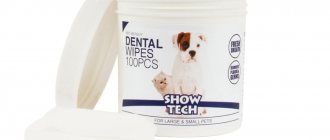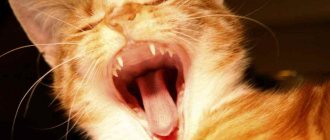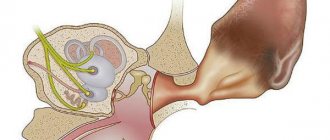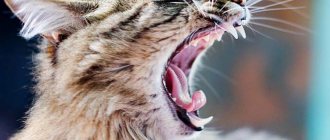Good hygiene is essential to maintaining the health of every pet. The main reason for the appearance of plaque is insufficient care of teeth and gums. The most common disease in every second cat is a lesion
tartar. Plaque does not cause cats much discomfort, but if measures are not taken, a dangerous disease can occur, including death. Therefore, brushing your cat’s teeth weekly is an important responsibility of every cat owner.
The need for oral hygiene
Cats belong to the order of predators. In the wild, the process of brushing teeth occurs naturally, because the cat's diet contains bones and cartilage of small animals and birds. They erase the plaque, and the teeth of wild predators remain white and smooth. Pets have a more varied menu, but it mainly consists of soft food. Many pets refuse to eat dry food, choosing pouches and pates. This causes plaque to remain in place and harden over time.
The stone is located on the neck of the tooth, in close proximity to the gums. Its gradual growth leads to the fact that the mucous membrane is injured and inflamed. If treatment is not started, a number of diseases may develop: caries, stomatitis, gingivitis, periodontal disease, osteomyelitis. The latter is characterized by purulent lesions of the jaw tissue, which can spread throughout the body. In this case, there is a risk of developing sepsis and death.
To prevent possible complications, all owners are recommended to perform hygienic cleaning of the oral cavity of their pets. The procedure should be performed at least twice a week.
Professional dental care
Professional removal of plaque and stones in a veterinary clinic is teeth cleaning with ultrasound.
This procedure allows you to completely remove plaque and tartar deposits from the entire dentition. The manipulation is performed with a special device - an ultrasonic scaler.
During this procedure, it is recommended to put the animal under anesthesia.
Why is anesthesia needed:
- To protect the animal from stress.
- To secure the animal.
- To avoid damaging the cat's oral cavity.
- To prevent water used for cooling from accidentally entering the trachea.
- To open the oral cavity as much as possible.
The procedure lasts from 30 to 60 minutes. 12 hours before cleaning, cats stop feeding; water is given for the last time an hour before the manipulation.
Process video
Tools and devices
To brush your cat's teeth, you will need toothpaste and a brush. Should cats' teeth be brushed with human hygiene products - under no circumstances! The paste will poison the animal, and the brush will damage the delicate gums.
Brush selection
Pet brushes vary in shape, size and material from which they are made. Pet stores sell:
- silicone models;
- with soft bristles.
The first ones are made in the form of a fingertip; instead of hairs, they have small teeth, which are used for cleaning. The latter differ from conventional brushes in the size and softness of the bristles. Some owners use toothbrushes designed for children in their first year of life. There are even those who brush their pets' teeth with regular gauze tied on their finger. The method is dangerous in the case of an aggressive cat, as it can bite a finger. It is quite acceptable for calm pets.
Toothpastes and gels
Toothpaste should be specifically designed for animals. Since pets do not know how to rinse their mouths, all residues are swallowed. Using simple menthol pastes on people can lead to severe food poisoning.
In order for the cat to more readily accept the cleaning manipulation, special flavors are added to the products (for example, meat or fish). Most often in pet stores you can find the following brands of drugs:
- Gel 8in1;
- Huts;
- FELINE HEALTH NUTRITION.
To remove the primary soft formation, you can purchase veterinary sticks for cleaning teeth. They are moistened with a special composition that softens and removes plaque.
What will be required for the procedure?
Cats have very sensitive and vulnerable gums. For this reason, regular toothbrushes are not recommended. In pet stores you can buy special kits with soft brushes that fit on your finger.
Such devices are very convenient for cleaning cat fangs and incisors, and most importantly, using them you can not be afraid of injuring your pet’s gums.
It is strictly forbidden to use ordinary toothpaste, since it is not only unsuitable for animals, but can also cause problems with the digestive system if accidentally swallowed.
Veterinary pharmacies and pet stores offer a wide selection of specialized products intended for oral hygiene of cats.
As a last resort, for the procedure, you can use a weak solution prepared on the basis of baking soda.
How does the procedure work?
It is not recommended to carry out manipulation without special training. If teeth cleaning for cats is the first time, you need to let the animal sniff objects that are new to it. You can offer to try the paste so that the taste and consistency are familiar to the cat. Thirty minutes before the start of the procedure, it is recommended to remove bowls of food and water.
Preparation
The first attempt to brush a cat's teeth may be unsuccessful if the pet is not accustomed to this. To prevent brushing your cat’s teeth from becoming stressful, and for the owner from becoming a traumatic procedure, you need to be well prepared:
- feed the cat 1.5-2 hours before the hygiene procedure;
- create a calm and quiet environment in your home;
- make sure in advance that the cat is familiar with all the cleaning items - brushes, bandages, a tube of paste;
- A particularly restless cat should be wrapped in a towel and held.
At first, you will most likely need an assistant. In the future, even one person can handle a cat accustomed to cleaning.
If the cat resists at the initial stage, it is better to let it go and let it calm down. A new attempt can be made later, when the animal is relaxed and friendly.
Direct cleaning
At first it will be unusual and difficult for you, but over time the procedure will become simple and fast. How to brush your cat's teeth yourself:
- Apply a little cleaning product to the brush;
- take the cat in your arms and place it on your lap with its back to you, trying to calm it down as much as possible;
- open your mouth with two fingers and slightly pull your lips to the sides;
- begin smooth movements without significant pressure from top to bottom, then along the entire dentition.
- If something bothers your pet or he doesn’t feel well, the procedure must be rescheduled for another day.
Brushing cats' teeth at home is contraindicated if they have oral diseases. These are inflammatory processes of the mucous membranes, bleeding gums, gingivitis, stomatitis, post-extraction alveolitis - inflammation of the hole at the site of the extracted tooth. It is necessary to approach the process with caution if your pet has a tendency to have epileptic seizures.
If, despite regular hygiene procedures, you notice a dark, hard plaque on your teeth that cannot be removed with a toothbrush, ultrasonic teeth cleaning is used.
Ultrasound cleaning of dental calculus is performed under general anesthesia in a veterinary office. It is not very cheap, but the stone is completely removed, and then you do not have to treat the cat for more serious diseases.
If the cat resists strongly
Since not every cat can brush its teeth, veterinarians allow several options for the hygiene procedure.
If a cat generally does not like violent actions, she will need a special retainer bag. The bag will help carry out regular procedures necessary for the health of the animal: cleaning eyes and teeth, combing, trimming nails, and medical treatment in case of illness. The cat will gradually get used to the bag and will not resist too much.
It happens that the main thing for an animal is to demonstrate its character. Then the owner needs to prove his authority and strength: you can tightly swaddle the cat and at least brush its teeth a little, thereby showing that you are serious. You should not shout, you need to talk to the animal in a firm, quiet voice. An adult animal understands human intonations perfectly and will reduce resistance in most cases.
If your pet is timid or begins to take revenge after every brushing of its teeth, you will have to look for an alternative. It will be more complicated and more expensive, but you cannot completely abandon hygiene - otherwise it will result in serious health problems.
Preparing the animal
Training a small animal is definitely easier than training an adult cat. In this regard, once the kitten is born, you should regularly set aside time for brushing your teeth.
Accustoming an adult pet to cleansing the mouth should be done gradually and correctly:
- You need to buy special hygiene products for the animal at the veterinary pharmacy. Human brushes and toothpaste are not suitable for cats, as they can damage gums and tooth enamel.
- Let your pet explore new items: sniff and examine. This will help him endure further teeth cleaning without panic.
- A few days before the procedure, you need to let the animal try the paste so that it is not frightened by new sensations.
- It is better to clean the oral cavity at a time when the cat has eaten and is about to sleep. At this moment, he will be as curious as possible, which can play in favor of the owner.
- If you have several pets living in an apartment, you will need to purchase an individual brush for each one to clean their mouth.
After completing the preliminary preparation, you can proceed to cleansing the oral cavity.
Frequency of manipulations
Veterinarians recommend carrying out a hygiene procedure 1-2 times a week, but many owners do not rest on this: should they brush their cat’s teeth more often? If the cat is already used to it and does not show aggression, then you can increase the frequency of procedures to 5-6 times a week, especially if the animal is prone to problems with the oral cavity.
The second controversial issue arises when comparing oral hygiene in humans and animals. People brush their teeth every day and still visit the dentist once every six months - for oral hygiene, fluoridation and other types of prevention. Does a cat need to have its teeth cleaned by a veterinarian if the owner does it regularly at home? No, it is not necessary if everything is fine with the animal. Professional laser cleaning is only necessary in case of tartar formation.
What to do if your pet resists
If an animal categorically refuses to perform hygiene procedures, you should not force it. Such actions are stressful for the cat .
It is recommended to select alternative cleaning options:
- Liquid paste. When used, the number of pathogenic microorganisms is reduced. The product is used according to the instructions: it is diluted with water (1 tsp of paste requires 1 glass of liquid), the resulting solution is added to drinking water. You should not use the product often because it can affect tooth enamel.
- Periodically replace soft food with dry food. They promote cleaning and massage the gums. Cats that constantly eat dry food should be given types that are designed to clean the mouth. Their granules have a unique structure and help remove plaque.
- It is recommended to give cartilage to pets that eat natural food (the consumption of tubular and flat bones is unacceptable). Raw meat is cut into pieces without chopping.
- You can purchase bones impregnated with an agent that prevents the formation of tartar.
- Special dental toys are purchased.
- You can add a small amount of toothpaste to food and apply it to toys.
- Use a spray that has an antibacterial effect. It is injected into the oral cavity after each meal.
When and how to teach a kitten to brush its teeth
You should begin introducing your cat to the teeth cleaning procedure as early as possible - 2-3 months after the pet moves into your home. The process is quite simple and does not take much time:
- After he has eaten, the kitten is placed on his lap and begins to be stroked.
- The index finger is bandaged with gauze and soaked in meat or fish broth. The baby is invited to sniff it and even taste it without biting it with his teeth.
- After a few days, the procedure is repeated, but the finger is carefully inserted into the oral cavity. And after a week they begin to massage their gums. If you find yourself in the period of changing milk teeth to molars, then the cat will definitely not refuse such pleasure.
- After a month, a brush takes the place of the finger, and instead of broth, toothpaste with added flavoring is used.
Handle your pet carefully, without raising your voice at him. The kitten, frightened by unusual actions and the scream of the owner, may dislike the procedure.
Teaching a cat to brush its teeth
The kitten needs to be accustomed to the presence of the owner's finger in its mouth. For starters, you can lubricate it with something sweet. This will help the baby get used to the subsequent procedure.
To clean the oral cavity of a small animal, you can initially use special gels with disinfectant properties to freshen breath. Over time, you need to carry out the procedure using a toothbrush and toothpaste.
In order for the cat to get used to the taste of the new product, you need to lightly lubricate your pet’s nose with it.
An adult pet should also be accustomed to brushing its teeth, although this will require a long time, maximum patience and perseverance. Since the pet has already grown up, it will be more difficult for him to get used to some actions or to the presence of the owner’s finger in his mouth.
Alternative Cleaning Methods
Owners are not always able to brush their cat’s teeth because the animal behaves too aggressively or fearfully. For such cases, there are alternative methods: they are effective, but quite expensive - the cost of the funds varies from 250 to 2000 rubles. You can find them in a pet store or veterinary pharmacy:
- Special sticks and pads are designed to clean enamel from tartar, polish, whiten and give a pleasant smell. These delicacies are made from meat products with the addition of vitamins, grains and antiseptics.
- Liquid paste is designed to remove tartar and protect gums from bacterial growth. This product is suitable for kittens and cats of all ages. It is necessary to dilute 5 ml of liquid in 300 grams of water and give it to the cat daily. The only drawback of this convenient method is the high price (around 1000 rubles).
- The veterinary spray is applied to the gums and teeth. Its disadvantage is that the cat still needs to be held tightly, but the owner is spared the work of using a toothbrush.
- Dental hard food helps strengthen teeth and protect the oral cavity. Consist of vitamins, microelements, grains and meat products. Solid granules clean and polish the enamel, removing plaque. The main thing is to remember to offer your cat plenty of fresh water.
- Special toys are designed for kittens: when baby teeth are replaced by molars, the baby experiences discomfort and constantly needs to chew on something. The toy is perfect for these purposes - it does not damage the gums and helps cope with itching.
Do cats need to have their teeth brushed at the veterinary clinic if none of the alternative and traditional remedies work? Definitely - as soon as a hint of tartar appears, you need to visit a veterinarian. He will put the cat under anesthesia and clean his teeth with an ultrasound.
Tips for cleaning your cat's mouth
The best option is to teach your pet to clean the mouth from childhood. The animal will get used to it and will not hide when it sees the owner with hygiene products in his hand.
Here are some recommendations for the procedure:
- The cat must get used to the owner's hands. To do this, you can feed the kitten by hand, and in the process touch the teeth;
- After the baby gets used to it, you can start wiping the tooth enamel with wet wipes. It is recommended to give your cat a treat before and after cleaning as encouragement. As an alternative, you can purchase a vitamin stick at a pet store - it is both a treat and beneficial for the oral cavity;
- When cleaning your teeth with a brush, it should be tilted at an angle of 45 degrees, and not vertically. Cleaning is carried out with gentle up and down movements on each side;
- The duration of the first procedure should be approximately 10 seconds for each row. Subsequently, the time increases to 30 seconds;
- Cleaning the gums is prohibited, especially with a hard brush, so as not to cause injury. There may be bleeding at first, but it will stop over time.
Do not forget that in natural conditions animals do not clean their mouths, so manipulation must be carried out very carefully.
Professional tartar removal
The most modern, effective and gentle way to remove tartar is ultrasonic cleaning. It is carried out in dental clinics. Hygienists or periodontists specialize in such procedures.
Before performing ultrasonic dental tartar removal, the doctor, guided by the main medical principle “Do no harm!”, assesses the condition of the patient’s oral cavity. Determines whether there are any contraindications. Selects a suitable nozzle for the ultrasonic cleaning device.
During ultrasonic exposure, the structure of the mineral plaque is destroyed. And in most cases this happens from within. Tartar simply falls off the surface of the enamel, falls out of periodontal pockets and interdental spaces.
After this, the enamel is polished. This is necessary in order to prevent the appearance of plaque for a long time. The result is not only noticeable - it is literally tangible. You can run your tongue over the surface of the enamel - it will be clean, smooth and tactilely pleasant.
If tartar has penetrated deep into periodontal pockets or has damaged the integrity of the enamel, causing increased sensitivity, the dentist can also use local anesthesia. This is necessary to make the procedure comfortable and painless for the patient.
Is it possible to remove tartar at home?
On the Internet and in printed publications you can find many recipes for removing stones yourself at home. This includes a mixture of black radish with lemon juice, decoctions of walnut bark, and other incredibly practical remedies that can be found in any garden.
But the problem is that they practically don't work. Decoctions of herbs and plants can have a positive effect on the soft tissues of the oral cavity, yes. But they won’t be able to cope with mineral deposits. Daily brushing will help remove bacterial biofilm, but not tartar. Attempts to soften mineral plaque with acid, as was done 25-50 years ago, will also not lead to anything good and can cause pain in already inflamed gum tissues and increase the sensitivity of the enamel.
Mineral tartar, unfortunately, cannot be completely removed at home. Not strawberry paste, not a mixture of black radish with lemon, not walnut bark decoctions, not soda, not a swab with hydrogen peroxide. Not a single one, even the most advertised brush or paste, can destroy mineral structures. But scratching, erasing healthy enamel or causing its increased sensitivity is quite possible.
The only effective and safe way to remove mineral plaque (tartar) from the surface of the enamel is to consult a dentist.









